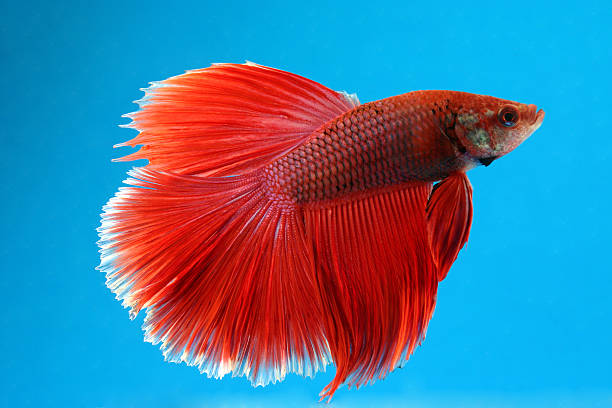Betta Splendens Care Guide
Betta Basics
Betta fish are native to the rice paddies, marshes, and flooded fields of Thailand and other areas of Southeast Asia. These warm, shallow, low-oxygen waters may stretch out for miles and the water is dark with tannins from leaf litter, wood, and other botanicals.
Minimum tank sizes in captivity:
- 5 US Gallons/19 liters (long fin bettas such as halfmoon, butterfly, or dumbo bettas)

- 10 US Gallons/38 liters (short fin/plakat bettas)
- 15 US Gallons/57 liters (giant/”king” bettas)
Temperature range: 78*-82*F/25.5-28*C
Water parameters: Tolerates a wide range of pH, gH, and kH but thrives in a slightly acidic to slightly basic pH (6.0-8.0). Though its native waters are typically soft, in captivity the betta tolerates most water hardnesses as long as levels stay consistent.
Diet
Readily eats commercially available foods including pellets and flakes. Seek a diet that is floating or slow-sinking (these fish eat from the surface of the water). Natural diets include insects, fry of other small fish, detritus worms, small aquatic organisms such as scuds, etc. A varied diet in captivity comprised of a high-quality pellet formulated for bettas, frozen foods such as bloodworms, live foods such as baby brine shrimp, vinegar eels, or black soldier fly larvae will benefit the betta in captivity and provide enrichment. Be sure not to overfeed as these fish are known for their appetites and are prone to obesity. Feed only a small amount at each feeding, just enough for your fish to eat within a period of a few minutes. Allow your fish to have a day without food once a week to allow the betta to forage in the tank and to reduce overfeeding. Some favorite brands of betta foods include Hikari Betta Bio-Gold Pellets, Fluval Bug Bites (Betta Formula), Invert Aquatics Ultimate Betta Bits, and Ultra Fresh Betta Pro Shrimp Patties.
Filtration
While they do best in filtered tanks, as all fish do, betta fish come from slow-moving waters and thrive in aquariums with gentle water movement. Consider a filter with an adjustable flow or a baffle to help prevent over-exertion, especially for bettas with very long, heavy fins. Sponge filters are excellent filter choices for betta fish as well as many nano species in the aquarium hobby. Delicate fins, tiny shrimp, and baby fish cannot get sucked into a sponge filter, and clean-up crew members love to graze on the sponge. The gentle flow provided by the bubbles is perfect for all types of betta fish, too. If you prefer a more traditional hang-on-back (HOB) filter, consider something with an adjustable filter output such as a Fluval AquaClear or Finnex PF-7 or similar. If your filter does not have adjustment options, you can take a piece of aquarium sponge, just slightly larger than the filter output (where the water flows back into the tank) and cut a slit into the sponge. Slip the sponge onto the filter output and now you not only have a homemade baffle for the filter but you also have an extra place for beneficial bacteria to colonize. You can slip a piece of sponge onto the filter intake tube (where the filter sucks water up from the tank into the filtration chambers) to help protect your fish too. Customize your filter’s media to suit your needs. Add ceramic media and sponge of different porosity for mechanical and biological filtration. Add filter floss to clarify water. Chemical filtration such as carbon is usually not necessary and needs to be replaced frequently.
Community compatibility
Each betta is an individual and must be treated as such. Many betta fish do not enjoy the company of other fish of any species. Most bettas do well with snail tankmates (nerite snails are fantastic additions to any aquarium as they do not reproduce in freshwater!) and many can be kept with shrimp. However, nearly all bettas (and fish in general) will happily make a meal of baby shrimp, regardless of how much you paid for that grade AAA bloody mary cherry shrimp colony. If choosing other fish to cohab with your betta, choose docile fish with less flashy colors and without long, flowy fins to ensure a peaceful group of companions. Small shoaling or schooling fish such as ember tetras, harlequin rasboras, corydoras (of any species, but especially hastatus or pygmaeus) do especially well. Other peaceful fish such as bristlenose plecos, kuhli loaches, and emperor tetras generally do well with a betta. Avoid other predatory fish or fish that may look similar to a betta such as cichlids, angel fish, gourami, and, of course, other bettas. Advanced keepers may wish to keep a community of female bettas, often referred to as a sorority, together, but this is not ideal for the beginner. Keepers who attempt a betta sorority must be prepared for the possibility of personality incompatibility and should have extra tanks on hand. Be sure to consider the size of your aquarium before adding schooling/shoaling species to your betta’s tank.
Other additions to the tank
In our aquariums, we can mimic their natural homes by providing our bettas with plants which will give the fish ample hiding places, shade from the harsh sun, cozy leaves to nap on, and natural clutter to make their tanks feel like home. Katappa leaves (ex. almond leaves), dried magnolia leaves, alder cones, mahogany pods, and other varieties of leaf litter break down to provide tannins in the water, a tea-colored natural wonder that can not only look cool but also provides antifungal and antimicrobial benefits. Tannins may also improve a betta fish’s immune system response. Similarly, hard wood such as Mopani or Manzanita driftwood will release tannins in the water, so feel free to add these natural items as hardscape pieces to your aquascape design. Plus, invertebrates will love the grazing opportunities provided by these items! If you use artificial decorations, make sure that the edges are smooth. Betta fins are incredibly delicate, especially on long-finned varieties. They are prone to tearing easily. If you take a pair of stockings or hose and drag them over the décor, any item that snags and tears the hose will potentially tear your betta’s fins. Silk plants are safer than plastic, but live plants will benefit your tank. Suggestions include cryptocoryne species, pogostomemon stellatus, ludwigia repens, and many others. Don’t be afraid to experiment with a variety of plants and see what grows.
General maintenance
Betta fish need warm clean water to survive. They are very curious fish and use every inch of tank space afforded to them. Be sure that your tank is heated and filtered before adding a betta. Always ensure that you have an established nitrogen cycle before adding any fish to your tank. Ammonia, nitrite, and nitrate (the by-products of fish waste) are all toxic to fish in their own rights and kill more fish within the first few months of fish ownership than any other disease. Ammonia toxicity is especially damaging to fish and can inflict permanent damage to a betta’s gills, scales, immune system, organs, and even slime coat. High enough levels of ammonia exposure can be fatal. To establish the nitrogen cycle without harming your fish, add pure ammonia to your tank until your ammonia level reads 2.0ppm. You’ll need an at-home aquarium test kit for this, such as API’s freshwater master test kit. Paper test strips are notorious for being inaccurate, so we recommend using a test kit with liquid reagents such as the kit from API. When ammonia eventually begins to drop, start testing nitrite levels. Any time ammonia drops below 1.0ppm, add more ammonia, enough to bring the level to 2.0-4.0ppm. Beneficial bacteria will begin to grow that consume ammonia. Nitrite is the waste product of this process. Nitrite is still toxic to fish. As ammonia is processed, nitrite levels will begin to increase, and, eventually, begin to decrease. Once this happens, you should start to see nitrate appear. Nitrate is the final byproduct of the nitrogen cycle and is the waste product of beneficial bacteria consuming nitrite (note the difference in spelling). Nitrate in high amounts is toxic, but we will reduce this number for our fish with water changes. Gradually, ammonia and nitrite will begin to process within 24 hours. When ammonia and nitrite both drop to 0ppm consistently within 24 hours of being fed a dose of pure ammonia, the tank has a strong enough colony of beneficial bacteria to support a fish. If you are keeping only a betta and a few invertebrates, your tank should be able to process 2ppm easily. If you are planning on keeping a more heavily stocked community tank, your tank should be able to process closer to 4ppm to accommodate a higher “bioload.” DO NOT FOLLOW THIS METHOD IF YOU ALREADY HAVE FISH IN THE AQUARIUM.
DO NOT THROW AWAY ANY FILTER MEDIA IN YOUR FILTER. Sponges, ceramic media, filter floss, even carbon cartridges that may come with the filter you choose will house your beneficial bacteria colony. This colony is your tank’s lifeline. Sponge and ceramic media will last decades. If your filter media becomes clogged with mulm or detritus (“gunk” or fish poop from the tank), simply give the media a rinse in OLD tank water during a water change to refresh the media. If you throw away your media, you’ll have to start the cycle process all over again and your fish may suffer.
Water changes
Water change schedules will be determined by the size of the bioload in your aquarium, how many live plants you have, how frequently and how much you feed your fish, and the size of your aquarium. A heavily planted 10 gallon aquarium with one betta, a nerite snail and two amano shrimp, for example, will only need 10-20% of the water changed weekly to every other week (possibly supplemented with plant fertilizers). A lightly planted 10 gallon aquarium with one betta, five male guppies, and 6 pygmy corydoras will likely need a water change of around 25% or more weekly. Monitor nitrate levels to guide your water change schedule. Once you have gotten into a steady maintenance routine, continue to check your ammonia, nitrite, and nitrate levels at least once a month to keep tabs on your water quality.
For nitrate levels between 0-10ppm: change 10% every other week
For nitrate levels between 10-20ppm: change 10% weekly
For nitrate levels between 20-40ppm: change 25% weekly
For nitrate levels between 40-80ppm: change 30% weekly
For nitrate levels higher than 80ppm: change 50% weekly



